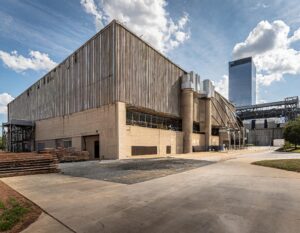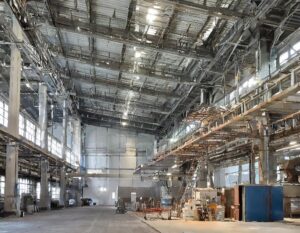- Demand and Supply Shift: Charlotte’s industrial market remains robust with low vacancy rates. However, the balance of supply and demand is changing, evidenced by a slowdown in leasing activity and a record level of new supply entering the market in 23Q2.
- New Construction Impact: New industrial deliveries have exceeded absorption for two consecutive quarters, with 19.0 million square feet (SF) under construction, primarily in large buildings over 500,000 SF, likely causing vacancies to rise throughout 2023.
- Size Discrepancy in Market Dynamics: A divide is appearing between large properties and smaller, infill properties, with the latter maintaining tight availability rates, whereas larger buildings are leasing more slowly due to declining consumer spending and retailers reducing excess inventories.
- Rental Growth Trends: Despite a slowdown, annual rental growth rates in Charlotte remain above the national average, with current rents at $9.10/SF, which is affordable compared to other Sun Belt markets.
- Investment Trends: Rising interest rates and economic uncertainty have caused industrial investors to pause, leading to a significant drop in total sales volume and a shift in interest toward infill properties, redevelopment opportunities, and sale-leasebacks.
- Market Resilience: Despite short-term challenges, Charlotte’s industrial market has long-term growth potential, with significant inventory expansion since 2010 and strategic location benefits.
- Geographic Advantages: Charlotte’s proximity to major markets and infrastructure investments, particularly along the Interstate 85 corridor, attracts distribution and warehousing demand.
- Federal Investments Impact: Federal investments in sectors like solar, electric vehicles, and semiconductor manufacturing will bolster the industrial market in Charlotte and the broader Southeast region.
- Cap Rate Movements: The investor caution has resulted in rising capitalization rates, reflecting changing perceptions of risk and return in the market.
- Strategic Industrial Expansion: The ongoing expansion in industrial real estate, fueled by strategic location and sectoral investments, positions Charlotte as a key player in the Southeast’s industrial landscape.
Page Contents
- Supply and Demand Dynamics
- Leasing Trends and E-commerce Influence
- Projected Deliveries and Market Impacts
- Sector-Specific Leasing Activity
- Discount Retailers and Market Adaptation
- Federal Investment and Market Growth
- Comparative Rent Affordability
- Submarket Rent Dynamics
- Construction Impact on Rent Growth
- Small Warehouse Market Tightness
- Construction Surge in Charlotte
- Speculative Developments and Tenant Commitments
- Strategic Geographic Positioning
- Market Dynamics in Different Property Sizes
- Investment Slowdown and Market Resilience
- Price Trends and Cash Infusions
- Cap Rate Dynamics and Investment Examples
- Closing Thoughts
Supply and Demand Dynamics
In
 dustrial space remains sought-after in Charlotte despite shifting market dynamics. Speculative construction and a slowing lease environment raised vacancies to 5.2%, according to CoStar. This rate is slightly above the national average as of mid-2023.
dustrial space remains sought-after in Charlotte despite shifting market dynamics. Speculative construction and a slowing lease environment raised vacancies to 5.2%, according to CoStar. This rate is slightly above the national average as of mid-2023.Leasing Trends and E-commerce Influence
Leasing activity in Charlotte saw a 44% decline in 23Q1 from the previous year. Still, new leases were robust, supported by population growth and e-commerce. Amazon’s expansion in Gaston County signifies sectoral solid activity.
Projected Deliveries and Market Impacts
Developers will complete over 19 million SF of industrial space in the next two years. This will pressure market fundamentals, particularly affecting larger buildings. Significant portions of this new construction still need to be unleased, increasing vacancies.
Sector-Specific Leasing Activity
Recent leases have predominantly involved smaller manufacturers. Larger deals have become rare, with the last major lease signed by Sherwin Williams. This shift indicates a changing landscape in industrial space utilization.
Discount Retailers and Market Adaptation
Discount retailers like TJ Maxx are actively leasing new spaces. This marks a change from previous years, where larger retailers dominated new leases. The market is adapting, with discounters playing a more significant role.
Federal Investment and Market Growth
Federal investments in sectors like electric vehicles and semiconductors are driving market growth. Companies like Arrival and Pallidus, Inc. are investing in the region, signaling strong industrial prospects. These developments enhance Charlotte’s attractiveness as an industrial hub.
Comparative Rent Affordability
Charlotte’s industrial rents are competitive compared to other Sun Belt cities. Affordability attracts manufacturing and logistics businesses, with rent growth at 15.1%. This rate exceeds the national average despite ongoing supply expansions.
Submarket Rent Dynamics
Premium rents are in areas with more flex space, like Mecklenburg Line and Cabarrus County.
 Like Rowan and Gaston Counties, exurban areas with new constructions offer lower rents. Sherwin Williams’ lease in Iredell County exemplifies the varied rent landscape.
Like Rowan and Gaston Counties, exurban areas with new constructions offer lower rents. Sherwin Williams’ lease in Iredell County exemplifies the varied rent landscape.Construction Impact on Rent Growth
Continued construction could temper rent growth, especially in logistics. The logistics sector sees robust rent increases, influenced by facility specifics and lease terms. Diverse rent rates reflect the sector’s dynamic nature and speculative construction effects.
Small Warehouse Market Tightness
Small warehouse spaces show limited construction, resulting in low vacancies and high rent growth. Tenants prioritize location over rent, opting for urban spaces to reduce transport costs. High demand for small spaces in strategic locations leads to premium rent rates.
Construction Surge in Charlotte
Construction in Charlotte accelerated due to high demand, with significant ongoing projects. Despite national trends of space reduction by large retailers, local absorption remains strong. Yet, the preleasing rate for large under-construction properties is relatively low.
Speculative Developments and Tenant Commitments
Major tenants like Macy’s are securing long-term leases in speculative developments. These large-scale projects are primarily in suburban areas, indicating a shift in development focus. Suburban submarkets are becoming critical areas for new industrial constructions.
Strategic Geographic Positioning
Charlotte’s location near major transportation routes makes it ideal for logistics and manufacturing. Proximity to Interstate 85 and 77 offers access to significant markets and ports. This strategic advantage drives demand for industrial space in the region.
Market Dynamics in Different Property Sizes
Focusing on large buildings has led to tighter availability in midsize and shallow bay properties. Smaller properties close to urban centers are in high demand, with low availability rates. This trend reflects a diversified demand across different property sizes and locations.
Investment Slowdown and Market Resilience
2023 saw a significant decline in industrial sales volume due to economic uncertainty. Interest rate hikes have paused many new deals, impacting institutional transactions. Yet, specific market segments like sale-leasebacks continue to show activity.
Price Trends and Cash Infusions
Charlotte’s industrial market prices have surged over three years, reflecting long-term value growth. Manufacturers sell properties to reinvest in their operations, as seen with Wheel Pros and Hexagon Agility. These sales highlight the ongoing liquidity and investment potential in the area.
Cap Rate Dynamics and Investment Examples
Cap rates in Charlotte have increased, signaling changing investor expectations. Notable transactions, like Met Life’s acquisition, demonstrate continued institutional interest. The varied cap rates across deals illustrate the market’s diversity and investment opportunities.
Closing Thoughts
Charlotte’s industrial market is evolving, with notable construction, leasing, and investment activities trends. Despite challenges, the market shows resilience and potential for long-term growth. Investors should watch these dynamics closely to make informed decisions. For expert guidance in navigating these opportunities, contact Lumicre for your investment needs.